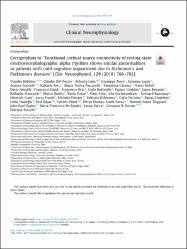Corrigendum to ‘‘Functional cortical source connectivity of resting stateelectroencephalographic alpha rhythms shows similar abnormalitiesin patients with mild cognitive impairment due to Alzheimer’s and Parkinson’s diseases” [Clin. Neurophysiol. 129 (2018) 766–782]

Göster/
Erişim
info:eu-repo/semantics/openAccessTarih
2019Yazar
Babiloni, ClaudioPercio, Claudio Del
Lizio, Roberta
Noce, Giuseppe
Lopez, Susanna
Soricelli, Andrea
Ferri, Raffaele
Pascarelli, Maria Teresa
Catania, Valentina
Nobili, Flavio
Arnaldi, Dario
Famà, Francesco
Orzi, Francesco
Buttinelli, Carla
Giubilei, Franco
Bonanni, Laura
Franciotti, Raffaella
Onofrj, Marco
Stirpe, Paola
Fuhr, Peter
Gschwandtner, Ute
Ransmayr, Gerhard
Garn, Heinrich
Fraioli, Lucia
Pievani, Michela
D'Antonio, Fabrizia
De Lena, Carlo
Güntekin, Bahar
Hanoğlu, Lütfü
Başar, Erol
Yener, Görsev
Emek-Savaş, Derya Durusu
Triggiani, Antonio Ivano
Taylor, John Paul
De Pandis, Maria Francesca
Vacca, Laura
Stocchi, Fabrizio
Üst veri
Tüm öğe kaydını gösterKünye
Babiloni, C., Del Percio, C., Lizio, R., Noce, G., Lopez, S., Soricelli, A. ... Stocchi, F. (2019). Corrigendum to ‘‘Functional cortical source connectivity of resting stateelectroencephalographic alpha rhythms shows similar abnormalitiesin patients with mild cognitive impairment due to Alzheimer’s and Parkinson’s diseases” [Clin. Neurophysiol. 129 (2018) 766–782]. Clinical Neurophysiology, 130(6), 1078-1078. https://doi.org/10.1016/j.clinph.2019.02.006Özet
Objective: This study tested the hypothesis that markers of functional cortical source connectivity of resting state eyes-closed electroencephalographic (rsEEG) rhythms may be abnormal in subjects with mild cognitive impairment due to Alzheimer’s (ADMCI) and Parkinson’s (PDMCI) diseases compared to healthy elderly subjects (Nold). Methods: rsEEG data had been collected in ADMCI, PDMCI, and Nold subjects (N = 75 for any group). eLORETA freeware estimated functional lagged linear connectivity (LLC) from rsEEG cortical sources. Area under receiver operating characteristic (AUROC) curve indexed the accuracy in the classification of Nold and MCI individuals. Results: Posterior interhemispheric and widespread intrahemispheric alpha LLC solutions were abnormally lower in both MCI groups compared to the Nold group. At the individual level, AUROC curves of LLC solutions in posterior alpha sources exhibited moderate accuracies (0.70–0.72) in the discrimination of Nold vs. ADMCI-PDMCI individuals. No differences in the LLC solutions were found between the two MCI groups. Conclusions: These findings unveil similar abnormalities in functional cortical connectivity estimated in widespread alpha sources in ADMCI and PDMCI. This was true at both group and individual levels. Significance: The similar abnormality of alpha source connectivity in ADMCI and PDMCI subjects might reflect common cholinergic impairment.

















